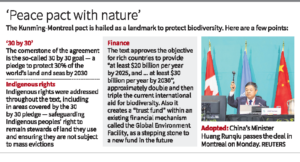Published on: December 20, 2022
Biodiversity Deal
Biodiversity Deal
Why in news? Nearly 200 countries, including India, approved a historic Paris-style deal called Kunming-Montreal Agreement to protect and reverse dangerous loss to global biodiversity, following an intense final session of negotiations at the UN COP-15 summit here in Canada.
Highlights

- The Chinese-brokered deal is aimed at saving the lands, oceans and species from pollution, degradation and climate change.
- The deal is being compared by many to the landmark plan to limit global warming to 1.5 degrees Celsius under the Paris Agreement.
What are the key areas agreed?
- Conservation, protection and restoration
- committed to protecting 30% of land and 30% of coastal and marine areas by 2030, fulfilling the deal’s highest-profile goal, known as 30-by-30.
- The deal also aspires to restore 30% of degraded lands and waters throughout the decade, up from an earlier aim of 20%.
- Money for nature
- Aim to ensure $200 billion per year is channelled to conservation initiatives, from public and private sources.
- Wealthier countries should contribute at least $20 billion of this every year by 2025, and at least $30 billion a year by 2030
- Democratic Republic of Congo’s main source of objection to the package.
- Big companies report impacts on biodiversity
- Companies should analyse and report their operations affect and are affected by biodiversity issues.
- Large companies and financial institutions being subject to “requirements” to make disclosures regarding their operations, supply chains and portfolios.
- Harmful subsidies
- Countries committed to identify subsidies that deplete biodiversity by 2025, and then eliminate, phase out or reform them.
- Agreed to slash those incentives by at least $500 billion a year by 2030, and increase incentives that are positive for conservation.
- Pollution and pesticides
- Focuses on the risks associated with pesticides and highly hazardous chemicals instead, pledging to reduce those threats by “at least half”, and instead focusing on other forms of pest management.
- Agreement will focus on reducing the negative impacts of pollution to levels that are not considered harmful to nature,
- Monitoring and reporting progress
- Aims for the support by processes to monitor progress in the future
- National action plans will be set and reviewed, following a similar format used for greenhouse gas emissions under U.N.-led efforts to curb climate change.

